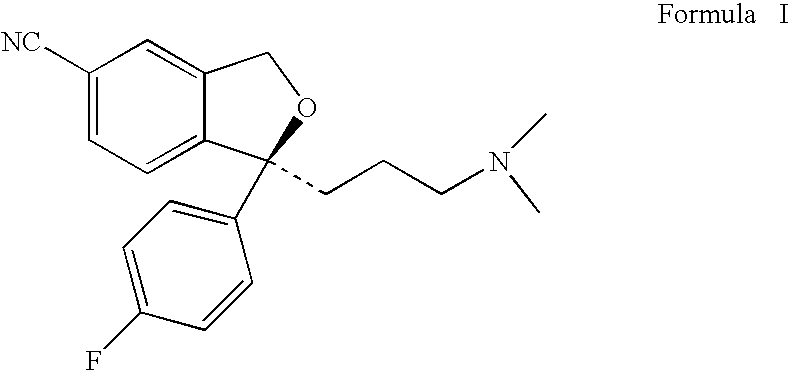Method of treating premenstrual dysphoric disorder with escitalopram
a technology of escitalopram and premenstrual symptoms, applied in the field of treating premenstrual symptoms with escitalopram, can solve the problems of monthly symptoms of dysphoric disorder (pmdd), marked interference with work, school, normal social activities,
- Summary
- Abstract
- Description
- Claims
- Application Information
AI Technical Summary
Benefits of technology
Problems solved by technology
Method used
Image
Examples
example 1
[0056] A double-blind, randomized, placebo-controlled trial evaluating the efficacy and safety of 3 months of intermittent treatment with 10 mg and 20 mg escitalopram per day in patients with PMDD is performed.
[0057] Intermittent treatment with 10 mg and 20 mg escitalopram oxalate daily is compared with placebo in a single-site, randomized, double-blind, parallel-group design.
[0058] 150 patients are required for the Full Analysis Set. Patients eligible for this trial are female outpatients aged at least 18 years with a regular menstrual cycle who meet the DSM-IV-TR criteria for PMDD. The trial consists of two periods, the screening period of 2 menstrual cycles and the treatment period of 3 cycles. During the entire trial period patients are to complete a diary with daily rating of symptoms by means of VAS (Visual Analog Scales, ranging from 0-100 mm).
[0059] During treatment, escitalopram is administered in the luteal phase of the menstrual cycle. Patient contacts are to be undert...
example 2
[0068] The procedure described in example 1 is repeated except the escitalopram oxalate is administered continuously throughout the menstrual cycle. The daily dose is 5, 10, 15, or 20 mg of escitalopram oxalate (calculated based on the weight of escitalopram base).
example 3
[0069] The procedure described in example 1 is repeated except the escitalopram oxalate is administered “semi-intermittently”, i.e., at a constant low dose during the follicular phase and a higher dose during the luteal phase. The regimen is: [0070] (1) 5 mg escitalopram or a salt thereof is administered daily for the first 2 days, and 10 mg is administered thereafter until the first day of full bleeding; [0071] (2) 5 mg escitalopram or a salt thereof may be administered daily for the first 1 day, 10 mg for 1 day (the second day), and 20 mg may be administered thereafter until the first day of full bleeding; [0072] (3) 5 mg escitalopram or a salt thereof may be administered daily for the first 1 day, and 10 mg may be administered thereafter until the first day of full bleeding; [0073] (4) 5 mg escitalopram or a salt thereof may be administered daily for the first 2 days, and a flexible daily dose between 5 mg and 20 mg can be self-administered by the patient thereafter until the fir...
PUM
 Login to View More
Login to View More Abstract
Description
Claims
Application Information
 Login to View More
Login to View More - R&D
- Intellectual Property
- Life Sciences
- Materials
- Tech Scout
- Unparalleled Data Quality
- Higher Quality Content
- 60% Fewer Hallucinations
Browse by: Latest US Patents, China's latest patents, Technical Efficacy Thesaurus, Application Domain, Technology Topic, Popular Technical Reports.
© 2025 PatSnap. All rights reserved.Legal|Privacy policy|Modern Slavery Act Transparency Statement|Sitemap|About US| Contact US: help@patsnap.com

